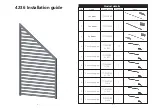
CAUTION
To prevent saturation o f the vertical
amplifiers,
the peak voltage to
ground at any am plifier input con
nector must not exceed 200 volts on
the
5,
10, and 20 VOLTS PER CM
ranges; 20 volts on the .5, 1, and 2
VOLTS PER CM ranges; and 2 volts
on all other ranges.
To obtain a voltage measurement with respect
to ground, perform the following steps:
1. To establish the reference line, touch the
probe tip to the oscilloscope ground terminal,
and rotate the TRIGGERING LEVEL control fully
clockwise to the RECURRENT position.
2.
Vertically position the trace to a convenient
point on the face of the crt. (This point will de
pend upon the polarity and amplitude of the
input signal, but it should always be chosen so
that the trace lies along one of the major divi
sions of the graticule. The graticule division cor
responding to the position of the sweep is known
as the ground reference line. (Do not adjust the
vertical positioning control after this reference
point has been established.)
3.
Remove the probe tip from ground and con
nect the probe to the signal source. Adjust the
TRIGGERING LEVEL control for a stable display.
4.
Measure the vertical distance in centimeters
from the point to be measured to the ground
reference line by use of the graticule.
5.
Multiply the setting of the SENSITIVITY con
trol by the distance measured to obtain the in
dicated voltage.
6
.
Multiply the indicated voltage by the at
tenuation factor of the probe you are using to
obtain the true voltage with respect to ground.
As an example of this method, assume that
you are using a 10X probe and a sensitivity of
.2 volts per centimeter and that after setting the
reference line at the bottom of the graticule, you
measure a distance of 8 centimeters to the point
you wish to measure. In this case then, 8 centi
meters times .2 volts per centimeter gives you an
indicated voltage of 1.6 volts. Since the voltage
point is above the ground reference line, the po
larity is indicated to be positive. The indicated
voltage times the probes attenuation factor of 10
then gives you the true voltage of positive 16
volts.
Fig. 3 -7 . Measuring the instantaneous voltage.
The vertical distance from the point of measurement to
a pre-established reference line is multiplied by the
setting of the SENSITIVITY control and by the attenua
tion factor of the probe to obtain the voltage measure
ment.
You should remember in determining the po
larity of voltages measured in this fashion that
inputs applied to the "B” input connectors are
inverted on the face of the crt. Consequently,
the apparent polarity of these inputs is opposite
the true polarity. To prevent possible confusion
as to polarity it is usually best to use the "A ”
input connectors for voltage measurements with
respect to ground.
TIME MEASUREMENT
Accurate elasped time or time interval meas
urements can be made by utilizing the calibrated
timebase feature of the Type 502 Oscilloscope.
The sweeps are calibrated so that the beams are
deflected across the screen at known rates.
Since the beam travels completely across the
screen in a known period of time, the time re
quired for the beam to travel any portion of
that distance can be determined. By measuring
the horizontal distance between points on the
displayed waveform, and by knowing the sweep
rate, you can determine the time interval be
tween the two points. You should use the same
precautions in finding the horizontal distance as
®
3-8
OPERATING INSTRUCTIONS — TYPE 502
Summary of Contents for 502 series
Page 2: ......
Page 6: ......
Page 7: ...Fig 1 1 Type 502 Oscilloscope with accessories ...
Page 8: ......
Page 36: ......
Page 50: ......
Page 77: ...0 0 TYPE 502 OSCILLOSCOPE A BLOCK DIAGRAM ...
Page 79: ...INPUT A M PLIFIE R SECOND D R IV E R O UTPUT A M PLIFIE R C F S AM PLIFIE R X 10 X 100 ...
Page 82: ...V722 type 502 o s c illo s c o p e HEATER WIRING DIAGRAM A POWER SUPPLY ...
Page 90: ...M ILLE RRUNUP CIRCU IT 350 V 2 3 M ILUSEC TIME BASE GENERATOR 12 8 58 ...
Page 94: ...CALIBRATOR MULTIVIBRATOR TYPE 502 OSCILLOSCOPE A ...
















































